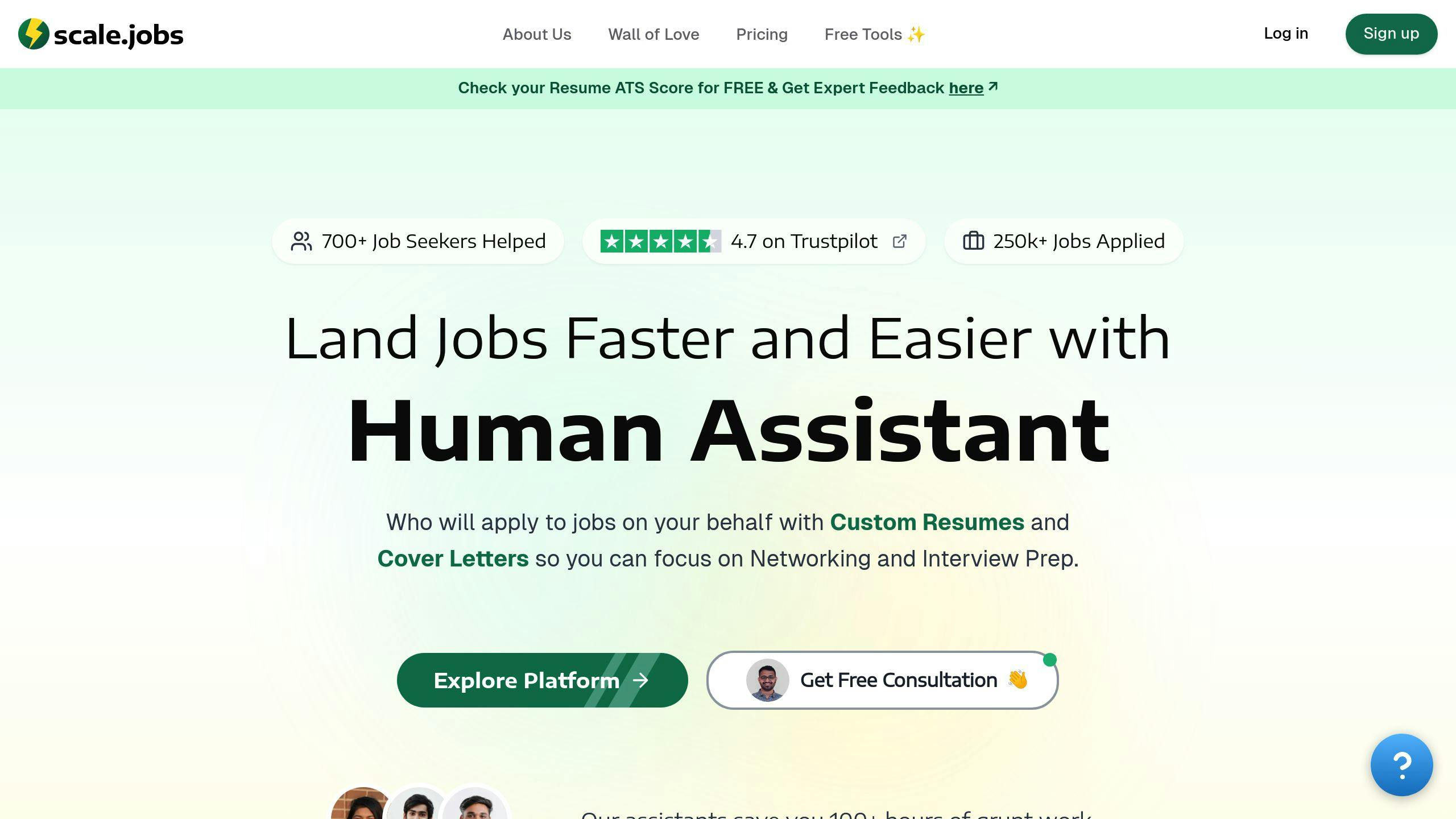7 Tips for Impromptu Speaking in Interviews
Enhance your interview skills with effective tips for impromptu speaking, ensuring clear communication and confident responses under pressure.

Struggling with unexpected interview questions? Mastering impromptu speaking can set you apart. Here's how:
- Listen actively: Understand the question fully before answering.
- Use frameworks: STAR (Situation, Task, Action, Result), Problem-Solution-Benefit, or Past-Present-Future help structure your answers.
- Pause strategically: Take a moment to organize your thoughts and avoid filler words like "um" or "like."
- Share examples: Use specific work experiences to highlight your skills, keeping responses concise and relevant.
- Focus on body language: Maintain eye contact, use intentional gestures, and sit confidently.
- Practice regularly: Mock interviews, recording yourself, and random topic exercises build confidence.
Why it matters: Employers value clear communication, critical thinking, and composure under pressure. These tips will help you handle the unexpected with confidence.
How to Improve Impromptu Speaking on The Spot
Tip 1: What Makes Good Impromptu Speaking
To do well in impromptu speaking during interviews, focus on delivering clear, structured answers that show you can think critically under pressure.
Strong impromptu speaking relies on three key elements:
- Active Listening: Fully concentrate to grasp the question's context and details.
- Organized Thinking: Arrange your ideas using helpful frameworks.
- Genuine Delivery: Share real experiences that reflect your abilities.
One helpful approach is the FAT framework (Feeling, Anecdote, Tie Back). For example, if asked about dealing with challenges, start by describing your feelings about the situation, follow with a specific story that relates to the challenge, and then connect it back to the role you're applying for.
Strategic pauses can work in your favor. They allow you to:
- Fully process the question.
- Structure your thoughts logically.
- Craft a response that directly answers what the interviewer is asking.
Avoid rushing, filler words like "um" or "like", and going off on tangents. Instead, aim for short, genuine answers that showcase your skills and why you're a good match for the job [1].
With these elements in mind, let’s dive into how to structure your responses effectively.
Tip 2: How to Structure Quick Responses
Giving clear and concise answers during interviews can be tricky, especially under pressure. Using proven frameworks can help you organize your thoughts and deliver responses that leave a lasting impression. Here are three practical methods to structure your answers effectively.
Using the STAR Method
The STAR method - Situation, Task, Action, Result - helps you share detailed and organized responses by walking through the context, your role, the steps you took, and the outcomes.
"The STAR method is meant to be simple. Sometimes people provide too much detail and their answers are too long." - Emma Flowers, Career Coach
Here's an example of how the STAR method works:
| Component | Example Response |
|---|---|
| Situation | "In my previous digital marketing role, our company needed to increase email subscribers." |
| Task | "As email marketing manager, I had to increase our subscriber list by 50% in one quarter." |
| Action | "I added content upgrades to old blog posts and organized a registration-required webinar." |
| Result | "Subscriber base increased by 60% in three months, exceeding the goal by 20%." |
Past-Present-Future Format
This approach connects your past experiences to the present role and your future goals. Start by highlighting relevant accomplishments, explain how your current skills align with the role, and wrap up by showing how you plan to contribute to the company's success.
Problem-Solution-Benefit Structure
This framework is perfect for showcasing your problem-solving abilities. Begin by explaining the challenge, describe the steps you took to address it, and finish by outlining the positive results. Here's an example:
"Last year while working as Customer Focus Manager with ABC Products Ltd in London, I successfully implemented a new process which reduced the time taken to process customer refunds from 14 days to 2 days, saving over £100,000 annually in agent time and gaining a 50% uplift in customer approval ratings."
These methods not only help you stay organized but also make it easier to remain calm and confident during interviews. Next, we’ll look at how active listening can further improve your ability to respond effectively.
Tip 3: Listen Before You Speak
Strong interview performance starts with active listening. This means more than just hearing words - it’s about fully understanding both what’s being said and what’s implied. Use your ears, eyes, and mind to pick up on verbal cues, tone, and body language.
When to Ask for Question Details
If a question isn’t clear, don’t hesitate to ask for clarification. You can rephrase the question, request additional context, or ask for examples. This shows you’re engaged and want to provide a thoughtful answer. However, limit this to one clarification per question to maintain confidence and professionalism.
"Active listening in an interview shows you are present, interested, and actively part of the conversation, not thinking about the next answer you want to give or the next question you hope to ask." - Nadia Ibrahim-Taney
Match Your Answer to the Question
To stand out, make sure your answers directly address the question. As Jeff H Sipe, an interview coach, puts it:
"Getting this step right will be a difference-maker that sets you apart from the competition."
Here’s how to do it:
- Pay attention to the interviewer’s tone, body language, and expressions to understand what they value most.
- Take a brief moment to gather your thoughts before answering.
- Confirm your understanding of the question if needed.
- Structure your response around key concerns: Can you do the job? Will you do the job? Do you fit in with the team?
ManpowerGroup highlights the importance of this skill, noting that "Active listening enables you to connect with the interviewer and hear what is really being said." It’s also a great way to show you can stay calm, focused, and think critically under pressure - qualities that are crucial in any role.
Once you’ve fully grasped the question, focus on delivering a clear and confident response that stays on point.
Tip 4: Managing Response Time
In impromptu speaking, how you handle your response time can greatly influence your ability to give clear and confident answers. Once you’ve nailed active listening, the next step is finding the right balance between thoughtful responses and keeping the conversation natural.
Using Pauses to Your Advantage
Strategic pauses can help you sound more confident and deliver smoother responses. Maryna Shkvorets, a Presentations and Communication Coach, explains:
"A good pause allows your last point to really sink in."
Here’s how to pause effectively:
- Take a moment to breathe before answering.
- Use phrases like "That's an excellent question" to buy time and organize your thoughts.
- Keep your pauses short - ideally under 10 seconds.
Even brief pauses of up to 5 seconds between ideas can enhance your credibility and give you time to compose your thoughts.
Cutting Down on Filler Words
After mastering pauses, focus on reducing filler words like "um" and "like", which can undermine your professionalism. Here are some proven strategies to help:
| Technique | How to Do It | Why It Works |
|---|---|---|
| Strategic Pausing | Replace fillers with short, intentional pauses | Shows confidence and control |
| Practice and Feedback | Record yourself or work with a partner | Helps identify and reduce bad habits |
| Deliberate Speaking | Slow down and speak with intention | Prevents nervous rushing |
"Embrace the silence. Part of the reason we use filler words is that we're designed to dislike silence in a conversation." - Recruiting in Motion
Tip 5: Using Work Examples
Once you’ve mastered your timing, adding work examples to your responses can make your interview answers stand out. The trick is to pick examples that highlight your skills while keeping them clear and to the point.
Using Examples Effectively
When using the STAR method (covered in Tip 2), your examples should be short but impactful. Aim for 1-2 minutes per example - this keeps your response detailed without losing the interviewer’s attention.
"The single most effective thing you can do in an interview is to make your experience come alive through stories or examples." - Emma Flowers, Career Coach
To make your examples count, focus on:
- Matching the job description
- Showcasing specific skills
- Highlighting measurable outcomes
- Using the STAR framework to stay organized
Tailoring Examples to the Role
Choose examples that directly reflect the skills needed for the role. Derek Bruce, HR & Operations Director, emphasizes:
"Candidates often forget to spend enough time talking about their actions and results, which are the most crucial parts of any example."
Your examples should:
- Directly relate to the job requirements
- Highlight your personal contributions
- Include numbers or results whenever possible
- Show how you solved problems effectively
For example, instead of vaguely stating you improved team communication, say: "The weekly standups I initiated reduced project delays by 30% and boosted team satisfaction scores by 45%."
"Want to know what topics to cover when you respond to your job interview questions? Tune in to what employers love to hear - concrete examples with measurable results." - Andrew LaCivita, Career Expert and Author
Strong examples are memorable, but pairing them with confident body language ensures they leave a lasting impact.
Tip 6: Body Language Skills
Your body language plays a huge role during impromptu responses in interviews. In fact, research shows that 55% of your message is conveyed through non-verbal cues, so it’s crucial to align your physical presence with what you’re saying.
Match Words and Actions
Your body language should work hand-in-hand with your words to strengthen your message. Here’s how to make your communication more effective:
| Message Type | Body Language | What It Communicates |
|---|---|---|
| Problem-solving examples | Leaning forward, engaged expression | Shows active involvement |
| Discussing achievements | Open palms, confident posture | Reflects honesty and pride |
| Team collaboration | Inclusive hand gestures | Highlights leadership skills |
| Technical explanations | Controlled movements | Adds clarity to your points |
"Hand gestures are not just random movements of your arms and hands. They are a form of nonverbal communication that can enhance your verbal message." - Career Communication Expert
Basic Body Language Rules
To project confidence and connect with your audience, focus on these key non-verbal elements:
Eye Contact and Posture
- Keep steady eye contact, shifting naturally between interviewers.
- Sit upright with relaxed shoulders.
- Plant your feet firmly on the ground for stability.
Effective Gestures
- Use open palm movements to appear honest and approachable.
- Keep your gestures intentional and controlled.
- Adjust the size of your gestures to match the importance of the topic.
"Looking down at your shoes or focusing on the table are actions that can convey a lack of confidence and nervousness." - Indeed.com
Key Mistakes to Avoid
- Crossing your arms, which can make you seem closed off.
- Excessive fidgeting, which distracts from your message.
- Slouching, as it suggests a lack of confidence.
Tip 7: Regular Practice Methods
Improving impromptu speaking skills for interviews takes regular effort. Just like any other skill, consistent practice helps you gain confidence and refine how you deliver your responses.
Practice Techniques That Work
Here are some practical ways to sharpen your impromptu speaking skills:
| Practice Method | Purpose | Benefits |
|---|---|---|
| Mock Interviews | Mimic real interview situations | Builds confidence under pressure |
| Recording Sessions | Review and analyze your performance | Highlights areas for improvement |
| Random Topic Practice | Practice thinking on your feet | Improves quick response ability |
Set aside 10-30 minutes each day to focus on these exercises. During this time, try:
- Using different interview scenarios to test your adaptability.
- Recording your answers and reviewing them critically.
- Timing your responses to keep them concise (1-2 minutes works well).
- Practicing with a partner or mentor who can offer constructive feedback.
Using Feedback to Improve
To get better, you need both consistent practice and actionable feedback. Here’s how to approach it:
Self-Assessment Tools
- Record your answers and review them to spot strengths and weaknesses.
- Use apps designed for speech analysis to track your progress.
- Try AI-based interview simulators for realistic practice sessions.
Professional Input
- Join public speaking groups to practice in front of others.
- Get feedback from seasoned professionals or mentors.
- Participate in mock interviews with peers to gain diverse perspectives.
"Regular self-assessment and seeking feedback are essential for measuring progress in impromptu speaking skills." - Career Communication Expert
The key is consistency. Even short, focused practice sessions can make a noticeable difference over time. By sticking to a routine and seeking feedback, you can turn impromptu speaking into one of your strongest assets in interviews.
Mastering Impromptu Speaking
Speaking on the spot takes preparation, practice, and staying calm under pressure. By following the seven tips we discussed earlier, you can turn tough interview questions into chances to highlight your strengths.
Success in impromptu speaking comes down to creating structured answers, listening carefully, and managing your time wisely - all key points we've covered. Practicing regularly, seeking feedback, and applying these skills in real-life situations will help you stay sharp and communicate clearly when it matters most.
"Confidence is critical as you learn to think on your feet." - LaRae Quy
Employers value strong impromptu speaking because it reflects essential skills, such as:
- Critical thinking
- Clear communication
- Emotional awareness
- Professional poise
- Flexibility under pressure
"Learning to speak with confidence can help you perform better in interviews, move ahead in your career, achieve important professional goals, and share your knowledge and views with others." - Michelle Dumas, CEO of Distinctive Career Services
Scale.jobs: Simplify Your Job Search

Improving your impromptu speaking skills takes consistent practice, and Scale.jobs makes it easier by handling the time-consuming parts of job searching. For just $4/hour, their virtual assistants take care of job applications and craft customized application materials, giving you more time to prepare for interviews.
Their platform offers tools that directly help you sharpen your interview skills:
| Tool | How It Helps with Interviews |
|---|---|
| Interview Questions Predictor | Anticipates potential questions and helps you practice clear and structured STAR responses |
| Actionable Feedback Engine | Delivers specific tips to refine your answers during interviews |
| Resume ATS Checker | Makes sure your resume highlights the experience you'll discuss in interviews |
"Our goal is to free up candidates' time for what matters most - preparing for interviews and networking. By handling the application process, we've seen candidates dedicate 60% more time to interview practice", says Leela Yanamaddi, founder of Scale.jobs.
The Interview Questions Predictor is especially useful for practicing organized and confident answers while still sounding natural. This way, you can focus on your delivery and presence instead of worrying about what to say.




